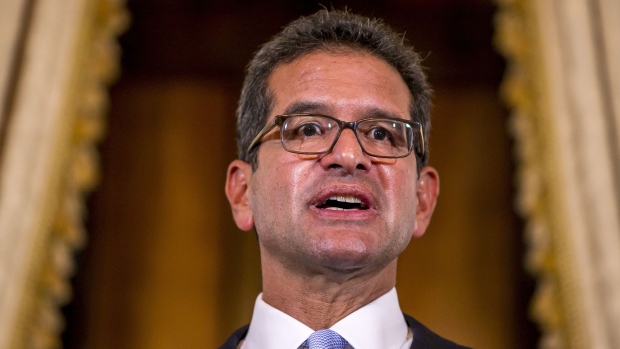Mar 15, 2022
Puerto Rico Is Out of Bankruptcy After a $22 Billion Debt Exchange
, Bloomberg News

(Bloomberg) -- Puerto Rico’s ended its nearly five-year bankruptcy as the commonwealth restructured $22 billion of debt, a crucial step that aims to help the island’s economy and repair its finances.
The U.S. territory cut the debt down to about $7 billion Tuesday through a bond exchange where investors hand in their securities for new general obligations. The transaction effectively ends Puerto Rico’s bankruptcy and resolves a major chunk of the $74 billion of debt that the island and its agencies had racked up when the bankruptcy began in May 2017.
“Today, the Puerto Rico government formally moves on from fiscal instability and insolvency into a future of opportunity and growth, making today a truly historic day,” David Skeel, chairman of the commonwealth’s federally appointed financial oversight board, said in a statement Tuesday.
A smaller debt burden allows Puerto Rico to work on improving its economy as billions of dollars in federal disaster funds, pandemic aid and hurricane insurance reimbursements flow into the island. Officials are focused on boosting tourism and increasing manufacturing.
In a brief address on Monday, Governor Pedro Pierluisi said the debt plan “wasn’t perfect,” but it paved the way for stability and economic development for the island’s roughly 3.3. million residents.
“The shadow of the bankruptcy has hampered our economic development, blocked our access to financing to pay for public works and wreaked havoc on public finances,” he said. “It has also jeopardized public worker pensions, kept the state from improving services or investing in its workforce. Those times are behind us. Now we close that chapter and begin to write a new history of prosperity.”
Puerto Rico’s bankruptcy is the largest and most expensive in the $4 trillion municipal-bond market, resulting in more than $1 billion in legal fees. The debt exchange will enable the commonwealth to begin repaying bondholders for the first time in almost six years.
Puerto Rico Bankruptcy Nears End on Eve of $22 Billion Debt Swap
The debt restructuring is the product of years of negotiations between the financial oversight board, commonwealth officials, bondholders, insurance firms and labor groups. Some of the island’s biggest bondholders include Aurelius Capital Management, BlackRock Inc., Allianz SE, Nuveen LLC and Invesco Ltd.
There will still be a formal closing of the case, but with the restructuring, Puerto Rico will be considered a “reorganized commonwealth,” effectively ending the bankruptcy, Brian Rosen, the board’s lawyer, said Monday during the media briefing on the debt exchange.
Puerto Rico can also begin hammering out a new debt restructuring deal with investors of its government-owned Electric Power Authority, which is going through its own bankruptcy. Restoring the island’s electrical grid is key to improving its economy as residents and businesses pay some of the highest electricity rates in the nation and suffer chronic outages.
The commonwealth’s restructuring addresses its broke pension fund, which owes current and future retirees an estimated $55 billion, by directing $1.4 billion to a new pension reserve trust. Puerto Rico will also allocate more than $10 billion to that fund in the next 10 years.
“Public service retirees will not have to be concerned that the government is somehow unable to pay their pensions in the future, as has been the case in the past,” Natalie Jaresko, executive director of the oversight board, said Monday during the media briefing.
High-yield Impact
For the municipal-bond market, Puerto Rico’s debt exchange means there will now be billions of high-yield commonwealth general obligations that are paying and done with court-ordered restructuring. That may attract more buyers of risker state and local debt who were waiting to invest in Puerto Rico securities post-bankruptcy, said John Ceffalio, senior municipal research analyst at CreditSights.
“They didn’t want to take that legal risk and now that’s off the table, you’re back to a little more old-fashioned municipal credit risk and that’s something that investors understand,” Ceffalio said.
Puerto Rico’s restructuring requires more stringent debt management. Several authorities will no longer be able to issue debt and future commonwealth borrowing will need to keep annual debt service costs to no more than 7.94% of the average revenue that the island collected in the prior two years.
“Creditors and the market in general will understand that Puerto Rico is a new credit now,” Omar Marrero, executive director of Puerto Rico’s Fiscal Agency and Financial Advisory Authority, said in a telephone interview Tuesday. “It’s a stronger credit and you have the guardrails in place necessary to make sure that we don’t get into the same mess.”
Future municipal-debt workouts may look to aspects of Puerto Rico’s restructuring, such as the creation of a contingent-value instrument that pays investors if there are surplus sales-tax collections and the formation of the new pension reserve trust, Skeel said during the board’s media briefing.
“There are a number of facets of this restructuring that people will look to in the future,” said Skeel, who teaches bankruptcy and debt restructuring at University of Pennsylvania Law School.
While Puerto Rico is about to put its bankruptcy behind it, risks remain. Bondholders may need to depend on the oversight board for future payments. The panel last month added principal and interest payments to Puerto Rico’s current budget after lawmakers failed to approve them.
“There is a certain amount of politics that’s involved right now that will hopefully disappear and everyone will become responsible parties,” Jaresko said.
The commonwealth also projects budget deficits will return in fiscal 2048, according to its latest multi-year fiscal plan. Even Pierluisi acknowledged during his celebratory address on Monday that there is still “a lot” of work ahead.
“As long as the board is there, bondholders will have a lot of confidence in the island’s willingness to pay,” Ceffalio said. “That’s an open question after the board leaves.”
©2022 Bloomberg L.P.






